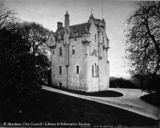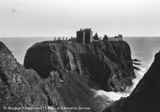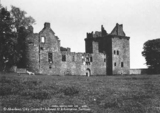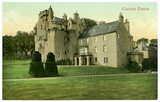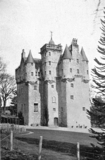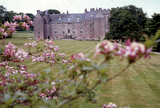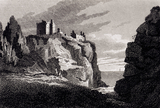|
Quick Search
|
Search Results
You searched for: Subject matches "Castles" or its children
21 items
items as
Postcard of ruins of Huntly Castle
288 Located on the outskirts of Huntly, the castle stands on the south bank of the River Deveron. The castle dates from the late 12th century with a Norman Motte and Bailey , a medieval L-Plan tower house and defence earthworks of the Civil War nearby. The castle was the home of the Gordons, a powerful Catholic family who once ruled over much of the North-East. The main structure was begun by Lord Gordon in 1452, being built in the new 'Palace' style. The castle was not completed in its final form until 1597/1606. In 1650 it was visited briefly by Charles ll, on his way to Worcester, defeat and exile. After the Civil War, the castle fell into disuse and the Dukes of Gordon moved to Fochabers. Much of the impressive ruin still remains including the fine heraldic doorway. The castle is now the property of Historic Scotland, and is open to the public. Balmoral Castle
1107 A George Washington photograph of Balmoral Castle from the north, looking towards Lochnagar. Dunnottar Castle
2232 A photograph of Dunnottar Castle taken from the mainland looking east. Dunnottar Castle is is a ruined medieval fortress located just under two miles south of Stonehaven. Crathes Castle
2548 A photograph of Crathes Castle. It is featured in 123 Views of "Royal Deeside" by Alex Inkson McConnochie. LUCRATIVE BUSINESS IN DANZIG
2878 With the substantial number of Scottish immigrants in Poland a reputation followed. "A Scots pedlar's pack" became a phrase used in Poland. The expression referred to the goods which the Scots had traded. Some of these goods were malt, flax, fruit, handkerchiefs, linen, woollen products, coal, fish and cloth.
As the Scottish minority made a visible contribution to the trade in Danzig, they earned another expression used among the Poles -"Szkot" (which means Scot in Polish). It was an epithet which referred to a business traveller.
The Scottish population in Poland increasingly grew in the 16th century due the career opportunities offered by the country. Areas of Poland consequently show the presence of these Scots. In 1576, Stefan Batory - the king of Poland at the time, designated a sector of Danzig to house Scots. "Nowe Szkoty" (New Scots) is an area in modern day Gdansk which has around 10 Polish villages with street names referencing the Scots who previously lived there.
The image on the left is of Cragievar Castle. This castle was owned by William Forbes. The funding for the property came from the riches he had made in Poland. Castle Fraser
4208 A photograph showing an interior within Castle Fraser, near Sauchen in Aberdeenshire.
The property belongs to the National Trust for Scotland who describe it on their website as "one of Scotland's largest tower houses, with an impressive portrait collection." A couple of portraits can be seen in this image.
This image likely dates from the 1970s. It comes from a collection of slides donated to Aberdeen City Libraries by Aberdeen City Council's publicity department. Castle Fraser
4209 A photograph showing the round tower and east wing of Castle Fraser.
Historic Environment Scotland on their CANMORE website state that "the Round Tower provides an excellent viewing platform of the landscape in all directions (although even from here Bennachie cannot be seen, contrary to some 19th century pictures of the Castle). The elevated position allows the topographic setting of the Castle and its designed landscape to be appreciated."
This image likely dates from the 1970s. It comes from a collection of slides donated to Aberdeen City Libraries by Aberdeen City Council's publicity department. Kellie Castle
4211 A photograph showing the southern elevation of Kellie Castle, or Kelly Castle, near Arbirlot and Arbroath in Angus. The castle sits in a wooded area next to a small river call the Elliot Water.
Historic Environment Scotland's Canmore website, states his that this historic tower house, also once known as Auchterlony, was "the seat of the Elliot family from the 14th to the 17th centuries but the building itself appears to date from the late 15th century at the earliest. After standing in ruins for some time it was restored in the mid-19th century and is still occupied."
This image likely dates from the 1970s. It comes from a collection of slides donated to Aberdeen City Libraries by Aberdeen City Council's publicity department. Drum Castle
4212 A photograph showing the south elevation of Drum Castle, near Drumoak, Aberdeenshire.
This image likely dates from the 1970s. It comes from a collection of slides donated to Aberdeen City Libraries by Aberdeen City Council's publicity department. Drum Castle
4218 A photograph showing a historical pageant type event taking place in front of Drum Castle.
A figure with what might be a microphone can be seen in the background at the top of the stairs. Many young people and adults are watching the show from behind a cordon. Some of the figures on the grass are wearing what looks like 17th century costume.
The photograph comes from a collection of slides from the 1970s and 80s donated to Aberdeen City Libraries by Aberdeen City Council's publicity department. Crathes Castle
4221 A photograph of Crathes Castle looking west across one section of its walled garden. This historic property can be found approximately 16 miles to the south west of Aberdeen. It is not far north of the River Dee before Banchory.
Kniphofia (Red-Hot Pokers) are the tall flowers in the foreground of this image. The garden's distinctive topiary yew trees can be seen on the left.
The castle is cared for by the National Trust for Scotland. Their website states that "Alexander Burnett built the castle in the 16th century, an intricate maze of turrets, towers, oak panels and painted ceilings, many of which survive beautifully to this day."
This image likely dates from the 1970s or 80s. It comes from a collection of slides donated to Aberdeen City Libraries by Aberdeen City Council's Publicity department. Dunnottar Castle
161 An engraving of Dunnottar Castle by J. Storer for the Antiquarian and Topographical Cabinet from a drawing by J.D. Glennie. Castle Terrace from Castlehill
427 This image was digitised from Artistic Aberdeen: A Sketch Book (1932) by W. S. Percy.
The book describes the scene as follows:
"Castle Terrace from Castlehill, looking towards the Maternity Hospital, with the Town House Tower in the distance. The Castlehill from earliest days has been associated with the military side of Aberdeen, and at the time of this publication is still occupied by the barracks which are the depot of the Gordon Highlanders. Castlehill overlooks river and sea, and it has been stated that earliest Aberdeen nestled in its shadow. Legend and history dealing in famous names such as William Wallace and Robert the Bruce and others not so dear to Scottish ears have surrounded Castlehill with the echoes of stirring events in Aberdeen's long history." |






